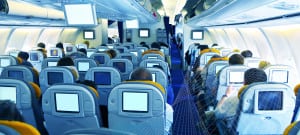Boost in Capacity, Avionics Innovations will Skyrocket IFC Revenues
[Via Satellite 03-16-2016] Euroconsult has released a report forecasting that total revenues from passenger In-Flight Connectivity (IFC) services will skyrocket from an estimated $700 million in 2015 to nearly $5.4 billion by 2025, a 23 percent Compound Annual Growth Rate (CAGR) over the 10-year period. A number of factors are contributing to the colossal growth, including the advent of High Throughput Satellite (HTS) systems, the increased use of aircraft connectivity for operational purposes, new entrants in the IFC provider market and a fragmentation of the antenna industry.
The “Prospects for In-Flight Entertainment and Connectivity” report finds that the number of connected commercial aircraft is expected to grow from 5,300 in 2015 to 23,100 by 2025, accounting for 62 percent of the global fleet. While the aeronautical market is highly sensitive to price, particularly in terms of equipment acquisition, installation and bandwidth pricing, which could inject some slow to the projected growth according to Geoffroy Stern, senior consultant at Euroconsult, and editor of the report, the amount of capacity set to enter the IFC market in the near future could work to drive down costs significantly. The launch of both Ka- and Ku-band HTS, which allow data speeds up to 10 times faster than those of regular satellite systems and at significantly lower cost, will trigger this huge jump in capacity.
“HTS systems will not only tremendously increase data speeds to planes — relative to the speeds offered by regular satellite systems — but do so at a significant lower cost, thereby further driving the adoption of IFC services,” Stern told Via Satellite. “With most existing Ku-band hardware installed on aircraft compatible with future Ku-band HTS systems, thus avoiding additional costs, the adoption of HTS is set to gain significant traction.”
Stern notes that a large volume of HTS capacity will be launched in the next three years. Ka-band HTS supply will increase threefold to reach 1,500 Gbps by 2018, while Ku-band HTS supply will increase fivefold to reach 285 Gbps in 2018, according to the report. A number of IFC providers are already primed to take advantage of this capacity as it comes online, with Gogo and Panasonic Avionics signing sizeable capacity deals with multiple operators in recent months.
The mounting bandwidth doesn’t end there. Beyond 2018, Stern expects an even larger volume of capacity to enter the IFC market.
“Panasonic announced that it is currently in the process of contracting a new generation of satellites that would offer extremely high throughput capacity. ViaSat announced at the end of 2015 that it intended to launch a global Ka-band constellation named ViaSat- 3 relying on three geostationary satellites, each with a capacity of up to 1 Tbps, with the first one expected to be launched in 2020,” Stern said.
As connectivity providers such as Panasonic, SITA OnAir, Gogo and Global Eagle Entertainment position themselves to take advantage of HTS systems coming online from companies such as ViaSat, Inmarsat, Intelsat and SES, they must also look to competition poised to threaten their hold on the market.
“Two new players are expected to enter the connectivity service market by 2017: SmartSky in the U.S., which intends to position itself in the ATG market, and AirCom Pacific, which aims to gain market share in the Asia-Pacific region. Both have already started to develop their own networks, with ATG sites under construction for the former and satellite capacity commitments for the latter,” said Stern.
Moreover, the IFC provider business model itself is beginning to come under fire as three satellite operators announced their intention to provide connectivity services directly to airlines, without the middleman, in 2015. “ViaSat has already started to do so with Virgin America, Inmarsat has signed a partnership with Lufthansa, and Yahsat has agreed to partner with Etihad Airlines to trial Ka-band connectivity services,” said Stern.
The antenna market is also set to diversify in coming years, which could provide some cost benefits to the aero IFC market as competition arises. “Despite having only four active players in 2015 — Panasonic, ViaSat, Aerosat and Tecom/QEST — the antenna-manufacturer market is poised for fragmentation, as no fewer than a dozen players are seeking to position themselves in the commercial aero segment, including Boeing, Rockwell Collins, Gilat, Hughes, Kymeta and Phasor,” said Stern. Thinkom, the antenna provider for Gogo’s 2Ku satellite-based IFC solution is also making a mark on the market and could further diversify the industry in coming years. According to Stern, this fragmentation could benefit service providers and end users by providing more cost-effective IFC equipment.
All of these improvements will likely lower cost, helping to make the business case for passenger connectivity and overcome potential barriers to growth, such as the hit from aircraft downtime that airlines must take in order to equip the aircraft, as well as installation bottlenecks that can slow market growth.
Operational connectivity will also help make the business case for commercial airlines as network enablement of avionics continues to evolve, allowing operators to discover new ways to use Internet Protocol-based (IP) connectivity to optimize their flight operations.
“While currently in its infancy, the smart plane concept is expected to develop further in the near future, and this should create untapped new opportunities for a wide range of players,” said Stern. The concept of the smart plane sees the aircraft as a node in a network of interconnected systems.
“Airlines are increasingly interested in using IP-enabled systems to provide not only passenger connectivity but also data communications between flight crews, cabin crews and ground-based personnel to improve maintenance and operations. These systems can provide real-time weather applications, tracking solutions, cabin crew applications and aircraft health-monitoring services,” said Stern. “The adoption will increase due to more reliable and affordable connectivity that is partly provided by HTS technology.”
